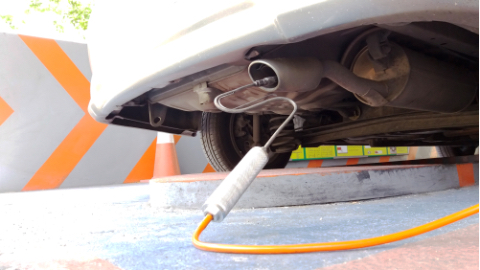
As part of the Horizon 2020 research project CARES (City Air Remote Emission Sensing), an international research consortium is working on new contactless exhaust measurement methods that will allow cities to take emission-reducing measures. The researchers are developing new sensors that can be attached to roadsides, crash barriers, or traffic signs which detect the exhaust emission of passing vehicles in a matter of seconds.
The sensor incorporates a two-tined tuning fork, with the tines initially set to vibrate using laser pulses. When airborne particles in the exhaust of passing vehicles pass between the tines, those particles become excited by the vibrations, causing each one of them to produce an audible signal. The greater the number of particles present, the louder the “sound” produced by the exhaust will be. If the sensor is combined with a camera that captures the license plates of the vehicles, then human users could identify which individual cars, trucks, or motorcycles are exceeding permissible emissions levels.
With such sensors, cities could introduce an emissions-based city toll: the higher the emissions of the car, the higher the charge would be. Entry permits into environmental zones could also be monitored automatically, with automatic barriers only opening if the pollutant emissions of the approaching car are within the standard range. The sensor technology could also be used to identify and remove from traffic those vehicles in which engine performance – and thus emissions – have been increased with manipulated particle filters or chip tuning.
Team leader Alexander Bergmann, head of the Institute of Electronic Sensor Systems at Graz University of Technology, expects low-cost remote sensors for emission measurement to be ready for series production by the end of 2022. Investigations will be carried out in live pilot operations as part of the CARES project in the cities of Milan, Prague and Krakow.
“We want to monitor vehicle emissions in cities and environmental zones under real conditions, without having to interfere with free-flowing traffic. The aim is to detect the exhaust class of each individual vehicle using these measurements,” said Bergmann.
